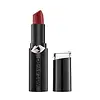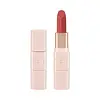What's inside
What's inside
 Key Ingredients
Key Ingredients

 Benefits
Benefits

 Concerns
Concerns

 Ingredients Side-by-side
Ingredients Side-by-side

Pentaerythrityl Tetraisostearate
EmollientIsononyl Isononanoate
EmollientOzokerite
Emulsion StabilisingKaolin
AbrasiveTriethylhexanoin
MaskingHydrogenated Microcrystalline Wax
Emulsion StabilisingSynthetic Wax
AbrasiveSilica
AbrasiveOleic/Linoleic/Linolenic Polyglycerides
EmollientMethyl Methacrylate Crosspolymer
Hdi/Trimethylol Hexyllactone Crosspolymer
Bis-Behenyl/Isostearyl/Phytosteryl Dimer Dilinoleyl Dimer Dilinoleate
EmollientCaprylic/Capric Triglyceride
MaskingHydrogenated Vegetable Oil
EmollientTrimethylpentanediol/Adipic Acid/Glycerin Crosspolymer
Skin ConditioningHydrogenated Styrene/Methylstyrene/Indene Copolymer
Dimethicone/Vinyl Dimethicone Crosspolymer
Skin ConditioningDipentaerythrityl Hexa C5-9 Acid Esters
Skin ConditioningMyristyl Lactate
EmollientBis-Diglyceryl Polyacyladipate-2
EmollientTriheptanoin
Skin ConditioningPhytosteryl Macadamiate
Skin ConditioningHelianthus Annuus Seed Oil
EmollientTocopheryl Acetate
AntioxidantPrunus Amygdalus Dulcis Oil
Skin ConditioningPhenoxyethanol
PreservativeSorbic Acid
PreservativeAstrocaryum Murumuru Seed Butter
EmollientPassiflora Edulis Seed Oil
EmollientPhytosteryl Oleate
Skin ConditioningTocopherol
AntioxidantArgania Spinosa Kernel Oil
EmollientMacadamia Integrifolia Seed Oil
Skin ConditioningEthylhexylglycerin
Skin ConditioningCocos Nucifera Oil
MaskingGlyceryl Caprylate
EmollientWater
Skin ConditioningGlycine Soja Oil
EmollientPentaerythrityl Tetra-Di-T-Butyl Hydroxyhydrocinnamate
AntioxidantSodium Hyaluronate
HumectantCI 42090
Cosmetic ColorantCI 77491
Cosmetic ColorantCI 77492
Cosmetic ColorantCI 77499
Cosmetic ColorantCI 45410
Cosmetic ColorantCI 15850
Cosmetic ColorantCI 77891
Cosmetic ColorantCI 19140
Cosmetic ColorantCI 15985
Cosmetic ColorantPentaerythrityl Tetraisostearate, Isononyl Isononanoate, Ozokerite, Kaolin, Triethylhexanoin, Hydrogenated Microcrystalline Wax, Synthetic Wax, Silica, Oleic/Linoleic/Linolenic Polyglycerides, Methyl Methacrylate Crosspolymer, Hdi/Trimethylol Hexyllactone Crosspolymer, Bis-Behenyl/Isostearyl/Phytosteryl Dimer Dilinoleyl Dimer Dilinoleate, Caprylic/Capric Triglyceride, Hydrogenated Vegetable Oil, Trimethylpentanediol/Adipic Acid/Glycerin Crosspolymer, Hydrogenated Styrene/Methylstyrene/Indene Copolymer, Dimethicone/Vinyl Dimethicone Crosspolymer, Dipentaerythrityl Hexa C5-9 Acid Esters, Myristyl Lactate, Bis-Diglyceryl Polyacyladipate-2, Triheptanoin, Phytosteryl Macadamiate, Helianthus Annuus Seed Oil, Tocopheryl Acetate, Prunus Amygdalus Dulcis Oil, Phenoxyethanol, Sorbic Acid, Astrocaryum Murumuru Seed Butter, Passiflora Edulis Seed Oil, Phytosteryl Oleate, Tocopherol, Argania Spinosa Kernel Oil, Macadamia Integrifolia Seed Oil, Ethylhexylglycerin, Cocos Nucifera Oil, Glyceryl Caprylate, Water, Glycine Soja Oil, Pentaerythrityl Tetra-Di-T-Butyl Hydroxyhydrocinnamate, Sodium Hyaluronate, CI 42090, CI 77491, CI 77492, CI 77499, CI 45410, CI 15850, CI 77891, CI 19140, CI 15985
Isononyl Isononanoate
EmollientNeopentyl Glycol Diethylhexanoate
EmollientDimethicone
EmollientCI 77891
Cosmetic ColorantCI 19140
Cosmetic ColorantAluminum Starch Octenylsuccinate
AbsorbentCopernicia Cerifera Wax
Dimethicone/Vinyl Dimethicone Crosspolymer
Skin ConditioningCI 15850
Cosmetic ColorantSynthetic Beeswax
Emulsion StabilisingLauroyl Lysine
Skin ConditioningSqualane
EmollientSynthetic Wax
AbrasiveDicalcium Phosphate
AbrasiveEuphorbia Cerifera Wax
Ricinus Communis Seed Oil
MaskingCellulose
AbsorbentCI 42090
Cosmetic ColorantParfum
MaskingSodium Hyaluronate
HumectantCI 77491
Cosmetic ColorantPentaerythrityl Tetra-Di-T-Butyl Hydroxyhydrocinnamate
AntioxidantHydrogenated Castor Oil
EmollientPolyhydroxystearic Acid
EmulsifyingIsononyl Isononanoate, Neopentyl Glycol Diethylhexanoate, Dimethicone, CI 77891, CI 19140, Aluminum Starch Octenylsuccinate, Copernicia Cerifera Wax, Dimethicone/Vinyl Dimethicone Crosspolymer, CI 15850, Synthetic Beeswax, Lauroyl Lysine, Squalane, Synthetic Wax, Dicalcium Phosphate, Euphorbia Cerifera Wax, Ricinus Communis Seed Oil, Cellulose, CI 42090, Parfum, Sodium Hyaluronate, CI 77491, Pentaerythrityl Tetra-Di-T-Butyl Hydroxyhydrocinnamate, Hydrogenated Castor Oil, Polyhydroxystearic Acid
Ingredients Explained
These ingredients are found in both products.
Ingredients higher up in an ingredient list are typically present in a larger amount.
Ci 15850 is the pigment color red. It is an azo dye and created synthetically.
Azo dyes need to be thoroughly purified before use. This allows them to be more stable and longer-lasting.
This ingredient is common in foundations, lipsticks, and blushes. This color is described as brown/orangey red.
It has many secondary names such as Red 6 and Red 7. According to a manufacturer, Red 6 usually contains aluminum.
Learn more about CI 15850CI 19140 is also known as Tartrazine. Tartrazine is a synthetic dye used in cosmetics, foods, and medicine to add a yellow color.
Tartrazine is created from petroleum and is water-soluble.
Some people may experience allergies from this dye, especially asthmatics and those with an aspirin intolerance.
Learn more about CI 19140Ci 42090 is a synthetic dye created from petroleum. It is used to give a bright blue color to cosmetics, medicine, and food.
Ci 77491 is also hydrated iron III oxide. It's sole purpose is to give a red/pink hue to products.
Iron III oxides are classified as inorganic chemicals for coloring.
Synthetically created Ci 77491 is considered safer than those naturally found. This is because the synthetically created version may contain less impurities. Iron oxides are generally non-toxic and non-allergenic.
Learn more about CI 77491Ci 77891 is a white pigment from Titanium dioxide. It is naturally found in minerals such as rutile and ilmenite.
It's main function is to add a white color to cosmetics. It can also be mixed with other colors to create different shades.
Ci 77891 is commonly found in sunscreens due to its ability to block UV rays.
Learn more about CI 77891This ingredient is a silicone used to improve the texture of products and absorb oil. It does not get absorbed into the skin.
Like other silicones, Dimethicone/Vinyl Dimethicone Crosspolymer helps condition the skin by creating a barrier. In this sense, it can act as an emollient and trap moisture in.
This ingredient is a type of elastomer.
Learn more about Dimethicone/Vinyl Dimethicone CrosspolymerIsononyl Isononanoate is a synthetic skin-conditioner and texture enhancer. It is created from nonanoic acid, a fatty acid found in cocoa and lavender oil.
As an emollient, Isononyl Isononanoate helps keep your skin soft and smooth. This is because emollients create a barrier on the skin to trap moisture in.
Isononyl Isononanoate helps give products a velvet feel and improves spreadability.
Learn more about Isononyl IsononanoatePentaerythrityl Tetra-Di-T-Butyl Hydroxyhydrocinnamate (long name, huh?) is a synthetic antioxidant.
It is used to help stabilize other antioxidants or prevent the color from changing in a product.
As an antioxidant, it helps fight free-radical molecules. Free-radical molecules are capable of damaging our cells and other genetic material. Thus, antioxidants may reduce the signs of aging.
This ingredient is oil-soluble.
Learn more about Pentaerythrityl Tetra-Di-T-Butyl HydroxyhydrocinnamateSodium Hyaluronate is hyaluronic acid's salt form. It is commonly derived from the sodium salt of hyaluronic acid.
Like hyaluronic acid, it is great at holding water and acts as a humectant. This makes it a great skin hydrating ingredient.
Sodium Hyaluronate is naturally occurring in our bodies and is mostly found in eye fluid and joints.
These are some other common types of Hyaluronic Acid:
Learn more about Sodium HyaluronateSynthetic Wax is created from fossil fuels such as natural gas. It is used to enhance texture, adjust pH, and as an occlusive.
It may also be used as an abrasive ingredient to exfoliate the skin.
Synthetic Wax may not be fungal acne safe.
Learn more about Synthetic Wax